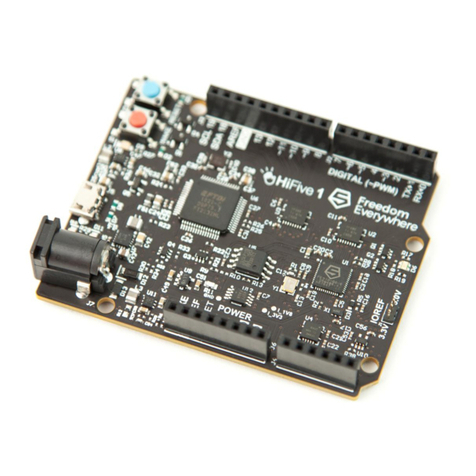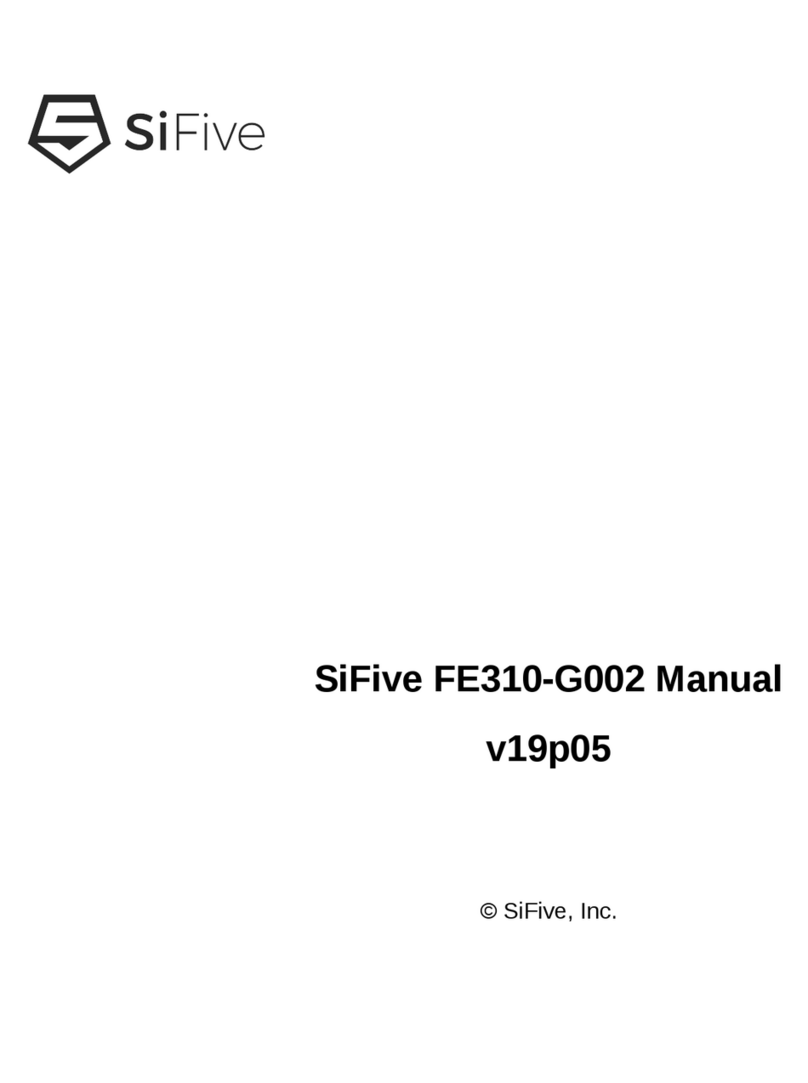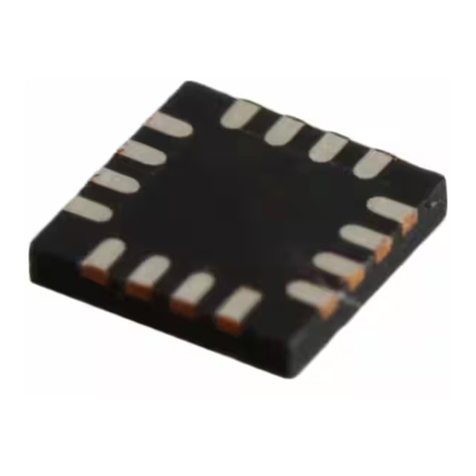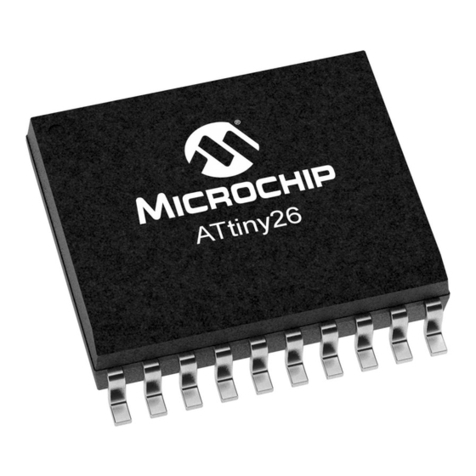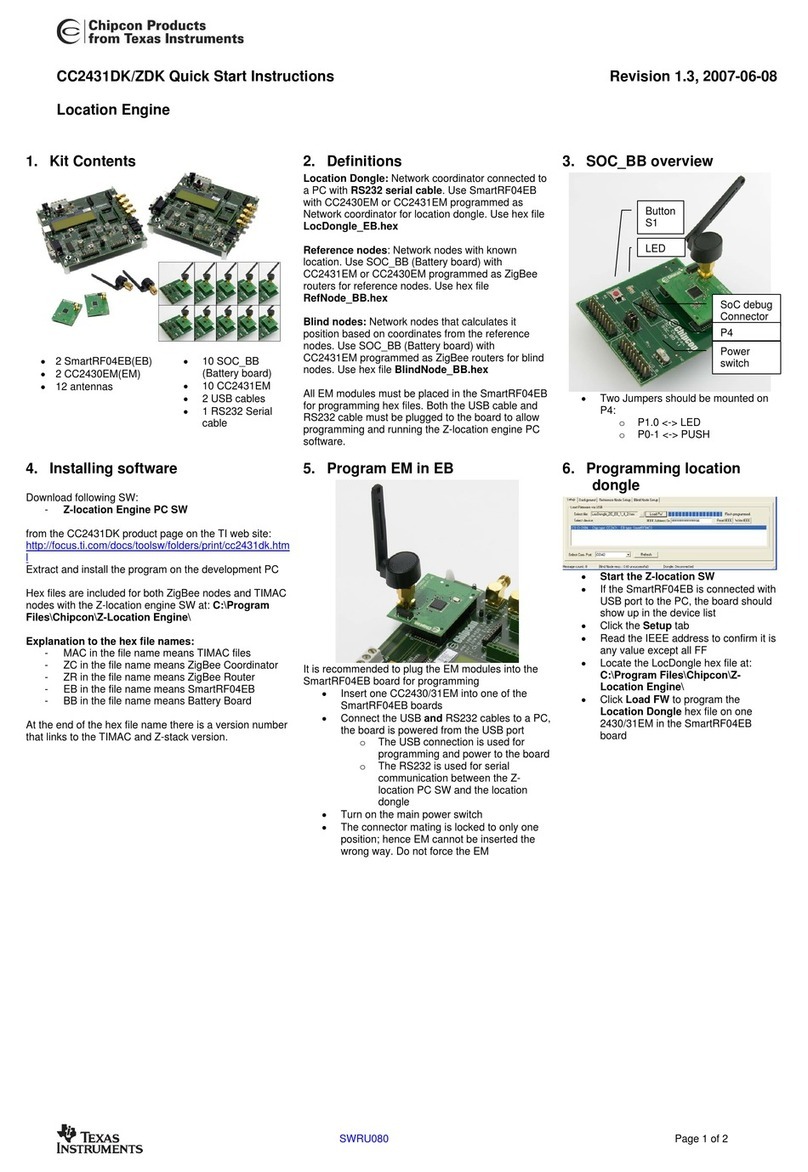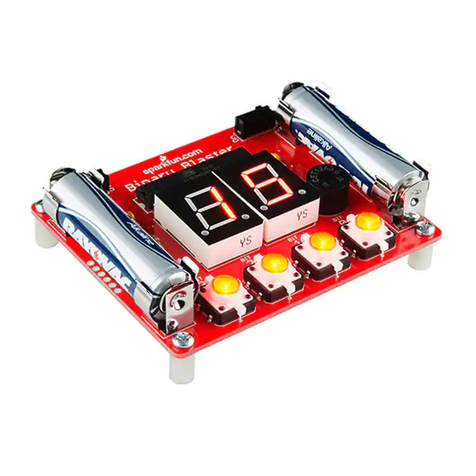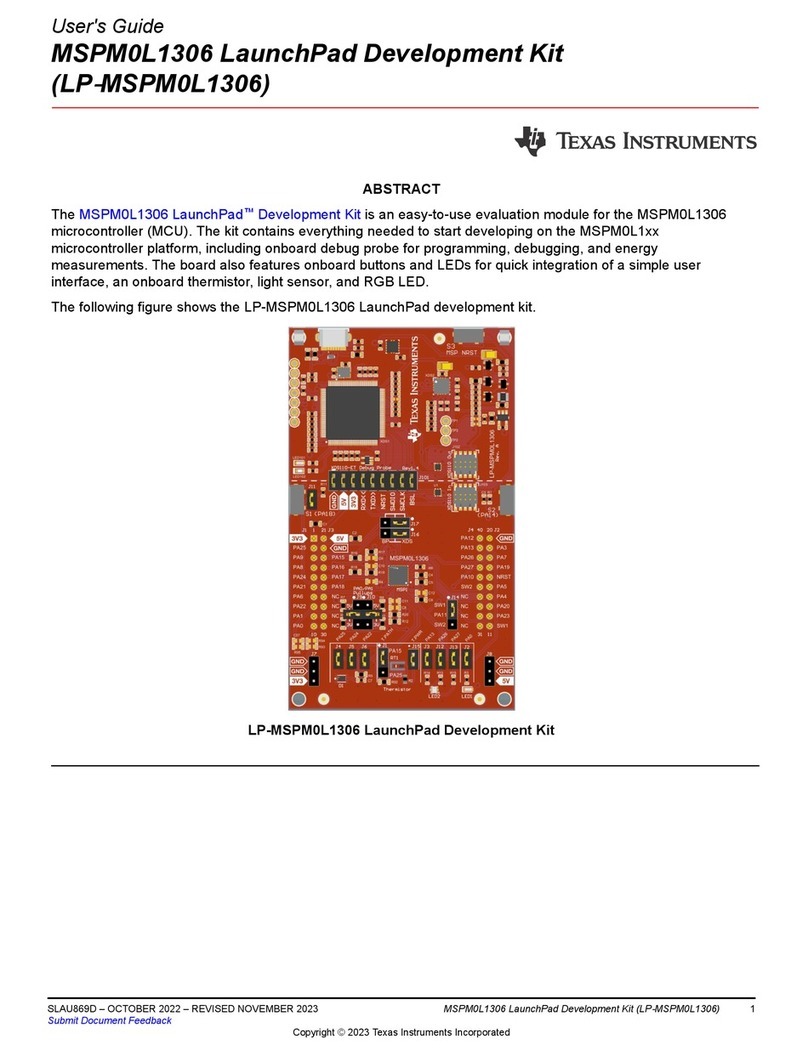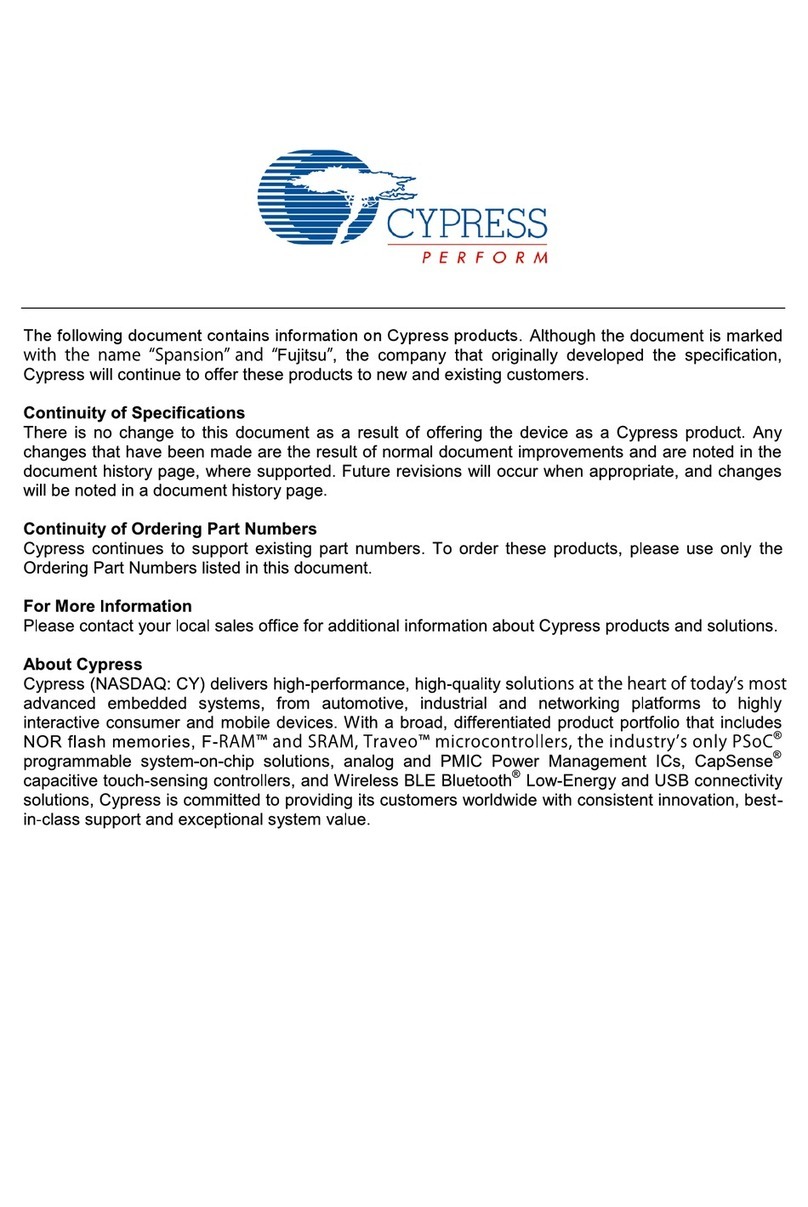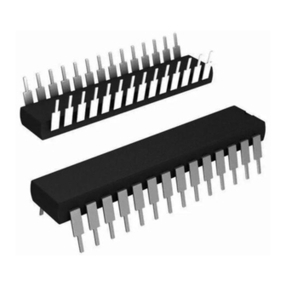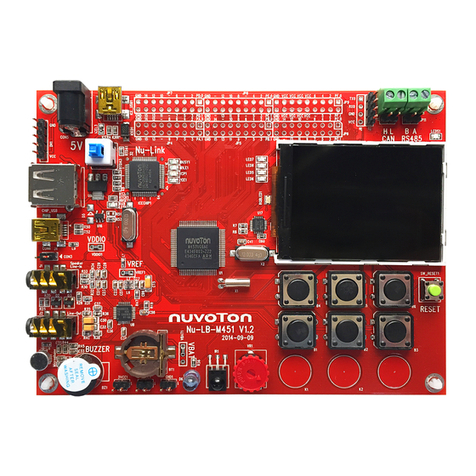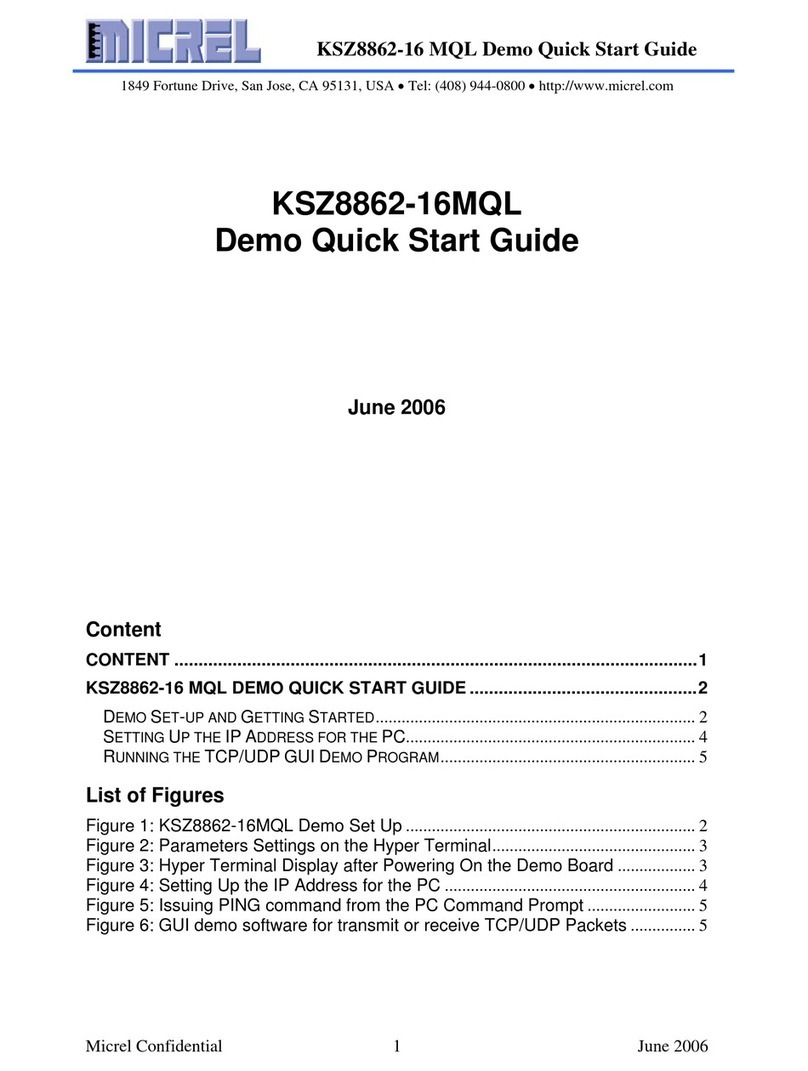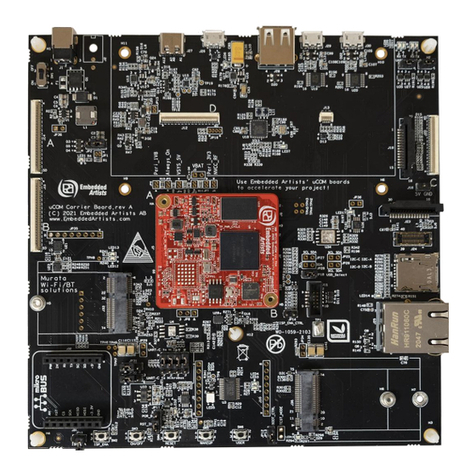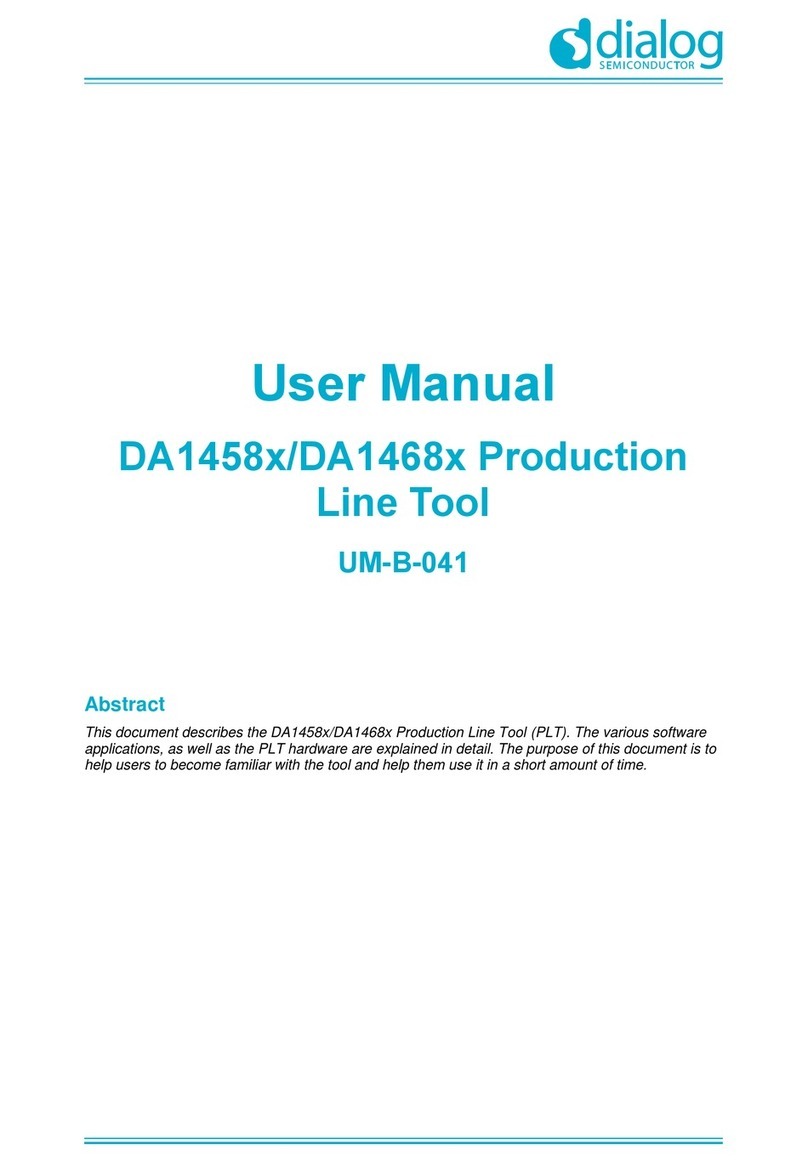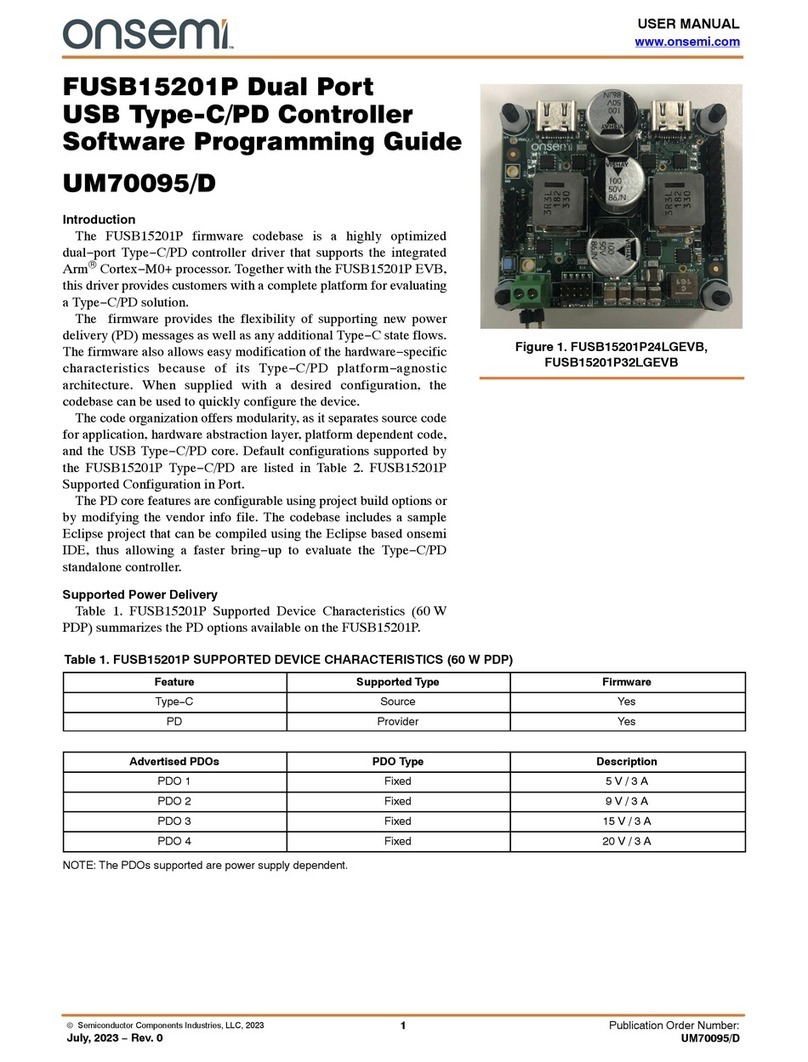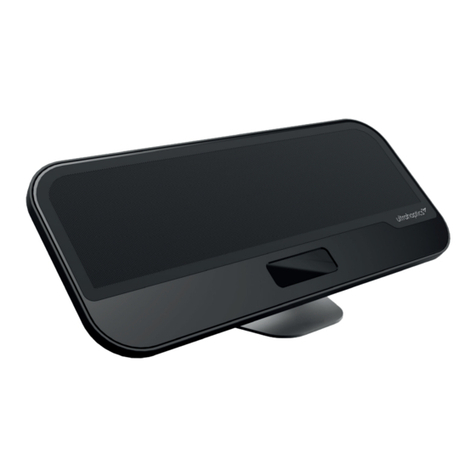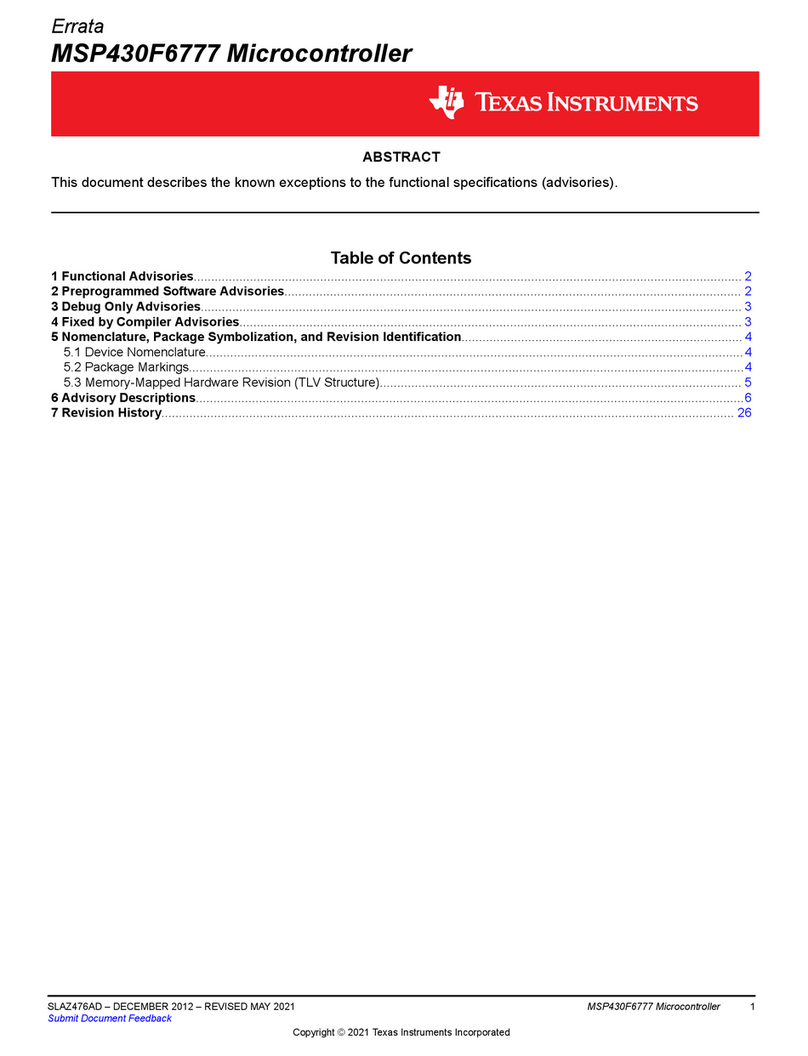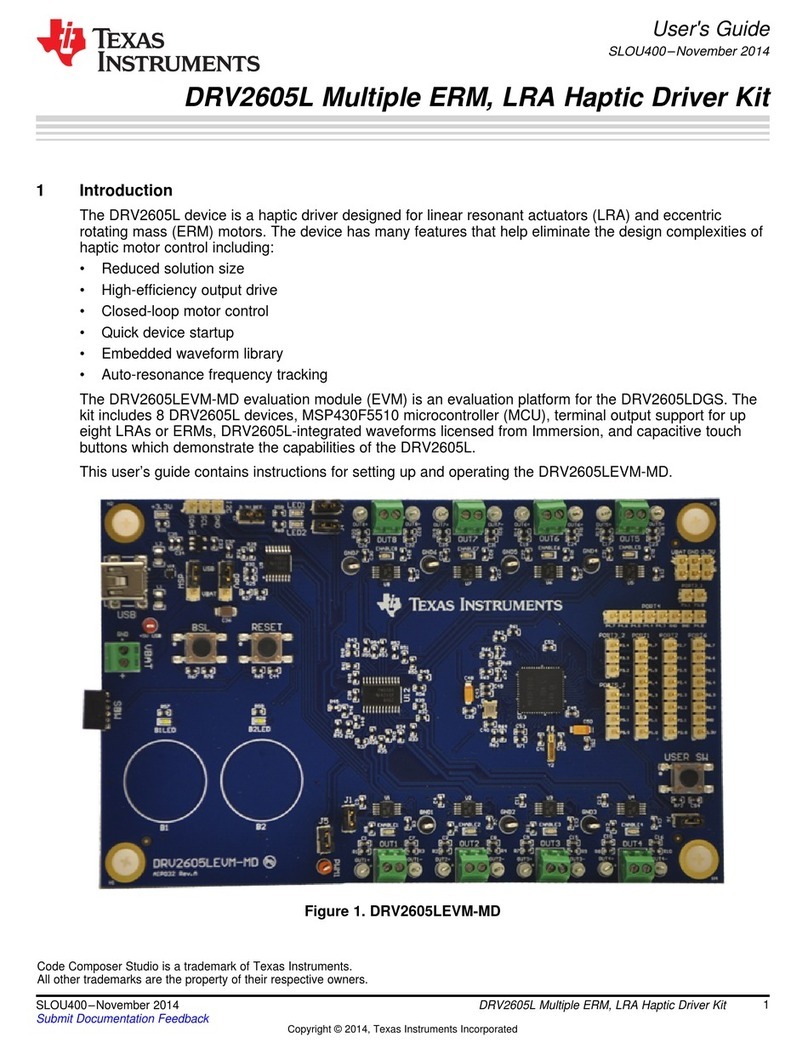SiFive E3* Core IP Series User manual

SiFive Core IP FPGA Eval Kit User Guide
v3p0
© SiFive, Inc.

2SiFive Core IP FPGA Eval Kit User Guide v3p0

SiFive Core IP FPGA Eval Kit User
Guide
Proprietary Notice
Copyright © 2016-2019, SiFive Inc. All rights reserved.
Information in this document is provided “as is”, with all faults.
SiFive expressly disclaims all warranties, representations and conditions of any kind, whether
express or implied, including, but not limited to, the implied warranties or conditions of
merchantability, fitness for a particular purpose and non-infringement.
SiFive does not assume any liability rising out of the application or use of any product or circuit, and
specifically disclaims any and all liability, including without limitation indirect, incidental, special,
exemplary, or consequential damages.
SiFive reserves the right to make changes without further notice to any products herein.
Release Information
Version Date Changes
v3p0 Feb 28, 2019 Updated for 19.02 Core IP Release
• Supports v19.02 Core IP Package
• Added descriptions for Arty-100T
• Added Chapters for E2, E3/S5, E7/S7 MCS
Images
v2p0 Feb 2, 2018 Updated to match v2p0 of the Evaluation MCS:
• FPGA Eval includes ITIM
• DTIM size increased to 64kiB
• Number of HWBP increased to 8
• Added User Mode Support
• Updated various links
v1p0 May 4, 2017 First release
i

ii SiFive Core IP FPGA Eval Kit User Guide v3p0

Contents
SiFive Core IP FPGA Eval Kit User Guide i
List of Figures v
1 Introduction 1
1.1 About this Document .................................. 1
1.2 About this Release ................................... 1
1.3 Evaluation Version Limitations ............................. 1
2 Required Hardware 3
2.1 Xilinx Arty A7 Artix-7 FPGA Evaluation Kit ...................... 3
2.2 USB A to Micro-B Cable ................................ 3
2.3 Olimex ARM-USB-TINY-H Debugger ......................... 3
2.4 USB A to B Cable .................................... 3
2.5 Male-To-Female Jumper Cables (10) ......................... 4
3 Board Setup 5
3.1 Connecting the USB Interface ............................. 5
3.2 Connecting the Debugger ............................... 5
4 FPGA Flash Programming File 9
4.1 Programming the Arty 35T SPI Flash ......................... 9
4.2 Programming the Arty 100T SPI Flash ........................ 10
5 Boot and Run 11
5.1 Serial Setup ....................................... 11
5.1.1 Reset and boot ................................ 13
5.1.2 Load a Program ............................... 13
iii

iv SiFive Core IP FPGA Eval Kit User Guide v3p0
5.2 Default Demo Program ................................. 13
5.2.1 Terminal Log ................................. 13
6 Software Development Flow 15
6.1 Supported Platforms .................................. 15
6.2 Software Development Using Freedom Studio IDE .................. 15
6.3 Software Development Using Freedom E SDK Command Line Tools ....... 15
6.3.1 Setting Up Freedom-E-SDK ......................... 16
6.3.2 Cloning the Repository ............................ 16
6.4 Freedom E SDK Arty BSP ............................... 17
6.5 Example Programs ................................... 17
6.6 Using the Freedom E SDK ............................... 18
6.6.1 Building an Example ............................. 18
6.6.2 Uploading to the Target Board ........................ 18
6.6.3 Debugging a Target Program ........................ 19
6.6.4 Cleaning a Target Program Build Directory ................. 19
6.6.5 Create a Standalone Project ......................... 19
7 E2 Core IP FPGA Eval Kit MCS Image Contents 21
7.1 Core IP FPGA Eval Kit Memory Map ......................... 21
7.2 Core IP FPGA Eval Kit Clock and Reset ....................... 21
7.3 Core IP FPGA Eval Kit Pinout ............................. 21
8 E3 / S5 Core IP FPGA Eval Kit MCS Image Contents 25
8.1 Core IP FPGA Eval Kit Memory Map ......................... 25
8.2 Core IP FPGA Eval Kit Clock and Reset ....................... 25
8.3 Core IP FPGA Eval Kit Pinout ............................. 25
9 E7 / S7 MCS Image Contents 29
9.1 Core IP FPGA Eval Kit Memory Map ......................... 29
9.2 Core IP FPGA Eval Kit Clock and Reset ....................... 29
9.3 Core IP FPGA Eval Kit Pinout ............................. 29
10 For More Information 33

List of Figures
3.1 Debugging Connections between Olimex ARM-USB-TINY-H and Arty Board’s
PMOD header JD ..................................... 6
3.2 Debug Connections To the Olimex ARM-USB-TINY-H ................. 6
3.3 Debug Connections to the Arty Board JD PMOD Header ................ 6
3.4 Photo of the Arty Board showing USB and Debug Connections ............ 7
7.1 E2 Core IP FPGA Eval Kit Block Diagram ........................ 22
8.1 E3 / S5 Core IP FPGA Eval Kit Block Diagram ..................... 26
9.1 E7 / S7 Core IP FPGA Eval Kit Block Diagram ..................... 30
v

vi SiFive Core IP FPGA Eval Kit User Guide v3p0

Chapter 1
Introduction
1.1 About this Document
This document gives necessary information for a user of the SiFive Core IP FPGA Eval Kit. To
learn more about the functionality of your specific Core IP please read the appropriate Core IP
Manual.
This guide will help you download and flash the Core IP FPGA Eval Kit image to an FPGA
development board. It will help you install software tools to allow you to write, upload, and debug
code on the Eval Kit. It also contains information about what is contained in the MCS file for the
Core IP FPGA Eval Kit.
1.2 About this Release
This Eval Kit allows you to prototype and benchmark your target RISC-V software without
modifying, integrating, or synthesizing any Verilog code.
This release is intended for evaluation purposes only.
1.3 Evaluation Version Limitations
Version v19.02 of the Core IP FPGA Eval Kit has the following limitations compared with the fully
functional Core IP:
• DTIM is limited in size to 64kB.
• Peripheral Bus, System Bus, and Front Bus are not exported for additional user connections.
The evaluation can utilize the peripherals included on the FPGA.
• Not all Local and Global interrupts are exported at the top level.
To target a different FPGA platform or perform synthesis or simulation, you may obtain an
Evaluation Version of the Core IP RTL from sifive.com.
1

2SiFive Core IP FPGA Eval Kit User Guide v3p0

Chapter 2
Required Hardware
The Core IP FPGA Eval Kit requires the following hardware:
2.1 Xilinx Arty A7 Artix-7 FPGA Evaluation Kit
The Arty A7 is a Xilinx FPGA development board for makers and hobbyists. The Arty A7 comes
in two FPGA variants: The Arty A7-35T features Xilinx XC7A35TICSG324-1L. The Arty A7-100T
features the larger Xilinx XC7A100TCSG324-1. Both can be purchased from Digilent or Avnet.
http://www.xilinx.com/products/boards-and-kits/arty.html
https://store.digilentinc.com/
2.2 USB A to Micro-B Cable
Any standard USB Type A Male to Micro-B Male cable can be used to interface with the Arty. Note
that the Arty kit does not include one.
http://store.digilentinc.com/usb-a-to-micro-b-cable/
2.3 Olimex ARM-USB-TINY-H Debugger
The Olimex ARM-USB-TINY-H is a hardware JTAG debugger. The Core IP Arty FPGA Dev Kit has
a standard JTAG debugging interface, and the tools included with the Core IP FPGA Eval Kit have
been tested using the Olimex ARM-USB-TINY-H. It can be purchased from Olimex or Digi-Key.
https://www.olimex.com/Products/ARM/JTAG/ARM-USB-TINY-H/
http://www.digikey.com/
2.4 USB A to B Cable
Any standard USB Type A Male to B Male cable can be used to interface to the Olimex ARM-USB-
TINY-H Debugger. Note that the package does not include one. These are available from a variety
of sources, including Digi-Key.
http://www.digikey.com/product-detail/en/assmann-wsw-components/AK672-2-1/AE1462-
ND/930247
3

4SiFive Core IP FPGA Eval Kit User Guide v3p0
2.5 Male-To-Female Jumper Cables (10)
The connection between the Olimex ARM-USB-TINY-H and Core IP FPGA Eval Kit requires 10
connections. These can be made with Male-to-Female jumper cables. These cables are available
from Adafruit in convenient rip-apart ribbon cables:
https://www.adafruit.com/products/826

Chapter 3
Board Setup
3.1 Connecting the USB Interface
Connect the USB Type A to Micro-B cable between the USB-JTAG port (J10) of the Arty and
the host machine. This provides UART console access to the Core IP FPGA Eval Kit as well
as a 5V power source for the board. This is also the interface by which the FPGA fabric will be
programmed.
3.2 Connecting the Debugger
The debugger is essential for downloading and debugging code with your SDK. The software will
be downloaded to SPI Flash, so it will be retained. Without the debugger you can only flash
the FPGA image and run the included demo program, you cannot change the software which
executes.
Connect the Olimex ARM-USB-TINY-H with the USB Type A to B cable to the host machine. Then
connect the Olimex ARM-USB-TINY-H debugger to PMOD header JD using the 10 jumper cables.
The pinout is as shown in Figure 3.1. Note that the Olimex ARM-USB-TINY-H and the PMOD
header on the Arty Board have different numbering schemes. Figures 3.2 and 3.3 clarify the
different pinouts for the two connectors.
Figure 3.4 shows what the board looks like with all the debug connections in place.
Note: It is important to connect to PMOD header JD (not JA, JB, or JC). JD was selected over the
other PMOD headers to avoid damage to the Arty board in the event of mismatched connections.
5

6SiFive Core IP FPGA Eval Kit User Guide v3p0
Signal
Name
ARM-USB-
TINY-H Pin
Number
Suggested
Jumper
Color
Freedom E310 Arty
Dev Kit JD Pin Number
VREF 1 red 12
VREF 2 brown 6 (“VCC”)
nTRST 3 orange 2
TDI 5 yellow 7
TMS 7 green 8
TCK 9 blue 3
TDO 13 purple 1
GND 14 black 5 (“GND”)
nRST 15 grey 9
GND 16 white 11
Figure 3.1: Debugging Connections between Olimex ARM-USB-TINY-H and Arty Board’s PMOD header
JD
1 : VREF (red) 2 : VREF (brown)
3 : nTRST (orange) 4
5 : TDI (yellow) 6
7 : TMS (green) 8
NOTCH 9 : TCK (blue) 10
NOTCH 11 12
13 : TDO (purple) 14 : GND (black)
15 : nRST (grey) 16 : GND (white)
17 18
19 20
LED
Figure 3.2: Debug Connections To the Olimex ARM-USB-TINY-H
square pad 1 : TDO (purple) 7 : TDI (yellow)
2 : nTRST (orange) 8 : TMS (green)
3 : TCK (blue) 9 : nRST (grey)
4 10
“GND” 5 : GND (black) 11 : GND (white)
“VCC” 6 : VREF (brown) 12 : VREF (red)
Figure 3.3: Debug Connections to the Arty Board JD PMOD Header

Copyright © 2016-2019, SiFive Inc. All rights reserved. 7
Figure 3.4: Photo of the Arty Board showing USB and Debug Connections

8SiFive Core IP FPGA Eval Kit User Guide v3p0

Chapter 4
FPGA Flash Programming File
The Xilinx Artix-7 35T or 100T FPGA configures on power-on from an on-board 16MB QuadSPI
Flash.
To program the Arty Board, locate the desired MCS file within your Core IP package. For example,
sifive_coreip_[XX]_FPGA_Evaluation_Arty_[35|100]T_v[XXX]_rc[xx].mcs
The Xilinx Vivado Design Suite is used for flash programming. Both the Vivado Lab Edition and
WebPACK Edition 2018.2 support Artix-7 devices free of charge.
4.1 Programming the Arty 35T SPI Flash
To program the Arty 35T SPI Flash with Vivado take the following steps:
1. Launch Vivado
2. Open Hardware Manager
3. Open target board
4. Right click on the FPGA device and select ”Add Configuration Memory Device”
5. Select the following SPI flash parameters:
Part m25ql128
Manufacturer Micron
Alias n25q1283˙
3vspi-x1 x2 x4
Family mt25ql
Type spi
Density 128
Width x1 x2 x4
6. Click OK to “Do you want to program the configuration memory device now?”
7. Add the MCS file
9

10 SiFive Core IP FPGA Eval Kit User Guide v3p0
8. Select OK
9. Once the programming completes in Vivado, press the “PROG” Button on the Arty Board to
load the image into the FPGA.
4.2 Programming the Arty 100T SPI Flash
To program the Arty 100T SPI Flash with Vivado take the following steps:
1. Launch Vivado
2. Open Hardware Manager
3. Open target board
4. Right click on the FPGA device and select ”Add Configuration Memory Device”
5. Select the following SPI flash parameters:
Part s25fl128sxxxxxx0
Manufacturer Spansion
Alias s25fl127s
Family s25flxxxs
Type spi
Density 128
Width x1 x2 x4
6. Click OK to “Do you want to program the configuration memory device now?”
7. Add the MCS file
8. Select OK
9. Once the programming completes in Vivado, press the “PROG” Button on the Arty Board to
load the image into the FPGA.

Chapter 5
Boot and Run
5.1 Serial Setup
Using a terminal emulator such as GNU screen on Linux or a terminal on Windows, open a console
connection from the host computer to the Core IP FPGA Eval Kit.
Set the following parameters:
Speed 115200
Parity None
Data bits 8
Stop bits 1
Hardware Flow None
For example, on Linux using GNU Screen:
sudo screen /dev/ttyUSB2 115200
You can use Ctrl-a k to “kill” (exit) the running screen session.
Depending on your setup, you may need additional drivers or permissions to communicate over
the USB port.
If you are running on Ubuntu-style Linux, the below is an example of steps you may need to follow
to access your dev kit without sudo permissions:
1. With your board’s debug interface connected, make sure your device shows up with the
lsusb command:
> lsusb
...
Bus XXX Device XXX: ID 0403:6010 Future Technology Devices
International, Ltd FT2232C Dual USB-UART/FIFO IC
2. Set the udev rules to allow the device to be accessed by the plugdev group:
11

12 SiFive Core IP FPGA Eval Kit User Guide v3p0
> sudo vi /etc/udev/rules.d/99-openocd.rules
Add the following lines and save the file (if they are not already there):
# These are for the HiFive1 Board
SUBSYSTEM=="usb", ATTR{idVendor}=="0403",
ATTR{idProduct}=="6011", MODE="664", GROUP="plugdev"
SUBSYSTEM=="tty", ATTRS{idVendor}=="0403",
ATTRS{idProduct}=="6011", MODE="664", GROUP="plugdev"
# These are for the Olimex Debugger for use with E310 Arty Dev Kit
SUBSYSTEM=="usb", ATTR{idVendor}=="15ba",
ATTR{idProduct}=="002a", MODE="664", GROUP="plugdev"
SUBSYSTEM=="tty", ATTRS{idVendor}=="15ba",
ATTRS{idProduct}=="002a", MODE="664", GROUP="plugdev"
3. See if your board shows up as a serial device belonging to the plugdev group:
> ls /dev/ttyUSB*
/dev/ttyUSB0 /dev/ttyUSB1 /dev/tty/USB2 /dev/tty/USB3
(If you have other serial devices or multiple boards attached, you may have more devices
listed). For serial communication with the UART, you will always want to select the higher
number of the pair, in this example /dev/ttyUSB2.
> ls -l /dev/ttyUSB2
crw-rw-r-- 1 root plugdev 188, 1 Nov 28 00:00 /dev/ttyUSB1
4. Add yourself to the plugdev group to eliminate the need to sudo for access to the device.
You can use the whoami command to determine your user name.
> whoami your user name > sudo usermod -a -G plugdev your user name
5. Log out and log back in, then check that you’re now a member of the plugdev group:
> groups
... plugdev ...
Now you should be able to access the serial (UART) and debug interface without sudo
permissions.
This manual suits for next models
4
Table of contents
Other SiFive Microcontroller manuals
